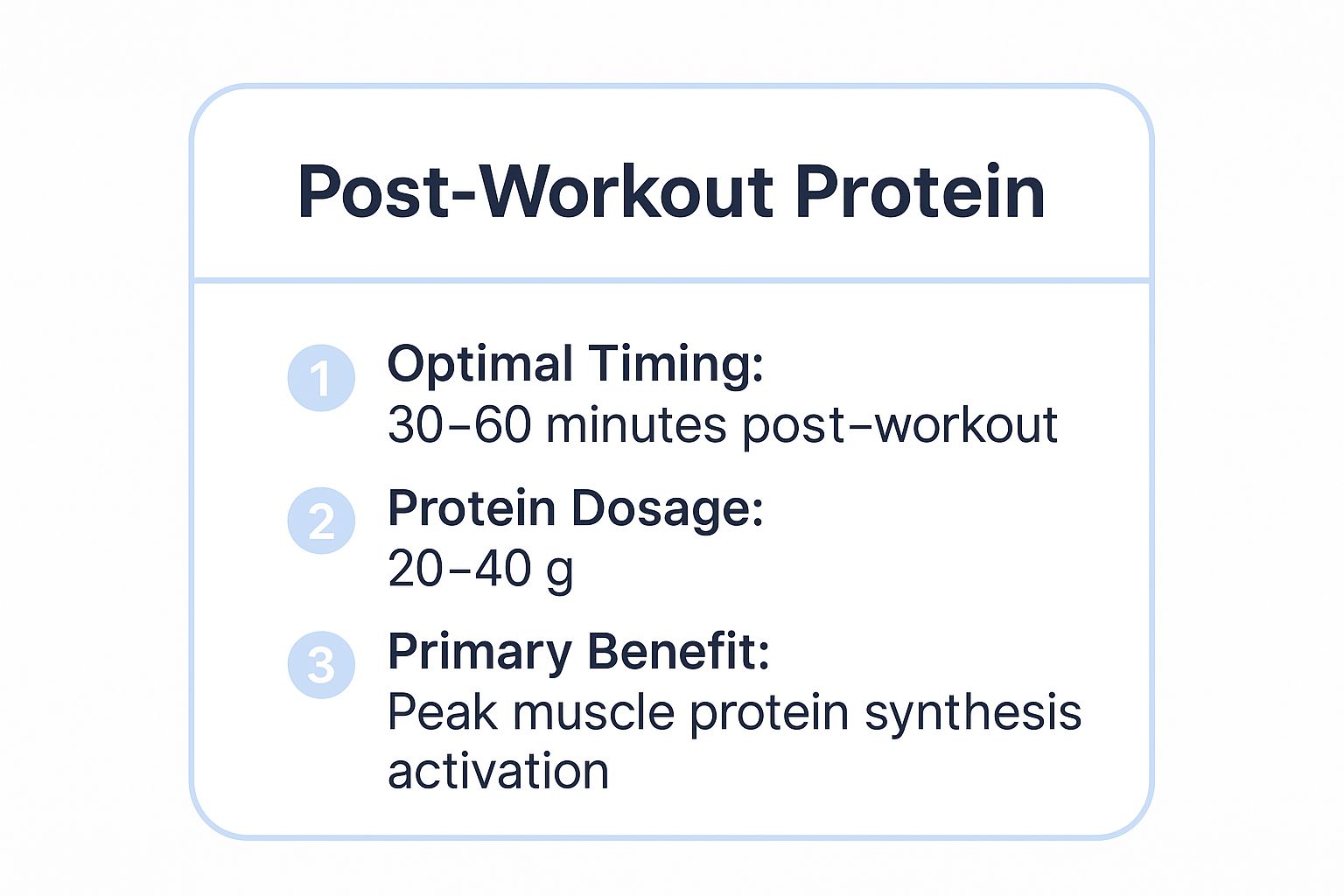You've chosen your protein, but a critical question remains: when is the best time to take protein powder to truly maximize its benefits? Timing isn't just a minor detail; it's a strategic component that can significantly influence muscle growth, accelerate recovery, and help you reach your fitness goals faster. The idea of an 'anabolic window' has dominated gym-talk for years, but modern science reveals a more nuanced picture.
It's not about one single 'perfect' moment, but rather understanding several key windows of opportunity throughout your day. Whether your goal is to build lean muscle, preserve it while dieting, or simply boost your daily intake, aligning your protein consumption with your body's needs is paramount. For a deeper dive into the science of protein optimization, including how much protein you really need and different types, consider these insights from a world-renowned protein expert on protein timing.
This guide moves beyond the myths to provide a science-backed breakdown of the six most effective times to use your protein powder. We'll explain the 'why' behind each one and offer actionable strategies to integrate them into your routine. Prepare to transform your protein strategy from guesswork into a precise, results-driven plan.
1. Post-Workout (30-60 Minutes After Exercise): The Classic Recovery Window
If you've ever stepped into a gym, you’ve likely seen someone shake up a protein drink immediately after their last set. This isn't just gym folklore; it's a practice rooted in the science of muscle recovery. This period, often called the "anabolic window," is arguably the most critical and well-known time to consume protein, making it the classic answer to the question of the best time to take protein powder.
Why This Window Matters
After strenuous exercise, your muscle fibers are broken down and are in a state of high alert, ready for repair. Your body is primed to absorb nutrients efficiently to kickstart this process. Consuming protein during this 30- to 60-minute window provides your muscles with the essential amino acids they desperately need.
This rapid delivery helps to halt muscle protein breakdown (MPB) and significantly boosts muscle protein synthesis (MPS), the process of building new muscle tissue. Think of your muscles as sponges post-workout; they are ready to soak up everything you give them to repair, rebuild, and grow stronger. This timing is a foundational strategy for anyone, from professional bodybuilders aiming for hypertrophy to endurance runners needing to repair muscle damage after a long race.
Practical Application and Tips
To make the most of this recovery window, timing and type of protein are key.
- Dose Correctly: Aim for 20-40 grams of high-quality protein to provide an adequate supply of amino acids without overwhelming your digestive system.
- Choose Wisely: Opt for a fast-digesting protein. While whey has traditionally been the go-to, Cantein hemp protein is an excellent plant-based alternative that is easily digestible and gentle on the gut, making it ideal for those with sensitivities.
- Boost with Carbs: Add a source of simple carbohydrates, like a banana or a tablespoon of maple syrup, to your shake. This helps replenish depleted glycogen stores and can enhance protein uptake by spiking insulin, a hormone that helps shuttle nutrients into your muscle cells.
To visualize the most important details for this timing strategy, here's a quick summary of the key data points.

As the infographic highlights, the combination of timing, dosage, and benefit makes the post-workout window a powerful opportunity for recovery. By capitalizing on this period, you directly support your body’s natural repair mechanisms. To get the most out of every gram, it's also crucial to understand how your body processes what you consume; learning how to optimize your protein absorption rates can make a significant difference in your results.
2. Pre-Workout (30-60 Minutes Before Exercise): Priming for Performance
While the post-workout shake gets most of the attention, consuming protein before you train is a powerful strategy for setting your muscles up for success. This approach, popular with researchers like Brad Schoenfeld and athletes like Layne Norton, focuses on creating an amino acid-rich environment in your bloodstream during your workout. The goal is to provide your muscles with fuel as they work, not just after they're finished.

This preemptive strike against muscle breakdown makes pre-workout protein one of the best times to take protein powder for muscle preservation.
Why This Window Matters
When you exercise, especially during intense resistance training or long endurance sessions, your body enters a catabolic state, breaking down muscle tissue for energy. Consuming protein 30-60 minutes beforehand ensures that a steady supply of amino acids is readily available to your muscles right when they need it. This can reduce the severity of muscle protein breakdown (MPB) during the workout itself.
By "front-loading" your protein intake, you are essentially giving your muscles a protective shield. This not only helps preserve your hard-earned muscle mass but can also enhance performance and kickstart the recovery process sooner. For powerlifters preparing for heavy lifts or bodybuilders in a calorie deficit, this timing can be particularly crucial for minimizing muscle loss and supporting strength.
Practical Application and Tips
To effectively use pre-workout protein, digestibility and timing are your primary concerns.
- Keep Portions Moderate: A serving of 15-25 grams is generally sufficient. Consuming too much right before training can cause digestive discomfort and weigh you down.
- Prioritize Easy Digestion: You need a protein that breaks down quickly without causing bloating. Cantein hemp protein is an excellent choice due to its gentle, plant-based profile, providing the necessary amino acids without the digestive distress some other proteins can cause.
- Time It Right: Give your body 30 to 60 minutes to digest the protein before you start your warm-up. This ensures the amino acids are circulating in your bloodstream when your workout begins.
- Experiment in Training: Always test a pre-workout protein strategy during a regular training session, never on a competition or race day, to see how your body responds.
By incorporating a pre-workout protein shake, you're not just preparing for the work ahead; you're actively supporting your muscles through every single rep. Properly fueling your body before a workout is a key component of athletic success, and you can discover more about how hemp protein can help fuel your workouts on Cantein.com to optimize your performance.
3. Upon Waking (Morning): Breaking the Overnight Fast
The sound of your alarm clock signals the end of a long, overnight fast. While you were sleeping, your body was hard at work repairing itself, but it was also in a catabolic state, meaning it was breaking down tissue, including muscle, for energy. Consuming protein first thing in the morning is a powerful strategy to flip this switch from catabolic (breakdown) to anabolic (building), making it a top contender for the best time to take protein powder.

Why This Window Matters
After 6-8 hours without food, your body's readily available amino acid pool is depleted. This forces it to pull amino acids from your muscle tissue to fuel essential bodily functions. A morning protein shake provides a rapid infusion of these crucial building blocks, effectively halting muscle protein breakdown and kickstarting muscle protein synthesis (MPS) for the day ahead.
This approach isn't just for bodybuilders like the legendary Dorian Yates, who famously used this timing to preserve mass. It’s also incredibly practical for busy professionals who need a quick, nutritious breakfast or for those practicing intermittent fasting who want to break their fast with a high-quality nutrient source. Starting your day with protein helps set the stage for stable energy levels and better appetite control throughout the day.
Practical Application and Tips
To effectively use protein in the morning, focus on speed of absorption and overall balance.
- Dose Correctly: A serving of 20-30 grams is sufficient to stop catabolism and stimulate MPS without being excessive.
- Choose Wisely: A fast-digesting protein is ideal here. For a plant-based option that is both effective and gentle on your digestive system first thing in the morning, Cantein hemp protein is an excellent choice. It delivers a complete amino acid profile to your muscles quickly.
- Enhance for Satiety: If your shake is your breakfast, add a source of fiber (like chia seeds or spinach) and healthy fats (like avocado or almond butter) to increase satiety and keep you full until your next meal.
- Plan Your Follow-Up: If the shake is just a kick-starter, plan to have a more balanced, whole-food breakfast within the next one to two hours to provide sustained energy.
4. Before Bed (1-2 Hours Before Sleep)
While the post-workout shake gets most of the attention, consuming protein before bed is a powerful, yet often overlooked, strategy for maximizing muscle recovery and growth. This approach focuses on nourishing your body during its most significant restorative period: sleep. Taking protein before bed ensures your muscles have a sustained supply of amino acids throughout the night, turning your sleep into a productive anabolic state.

This timing strategy has been popularized by figures like Dr. Luc van Loon, whose research has highlighted the benefits of nighttime protein feeding for muscle synthesis. Professional athletes and bodybuilders also commonly use this method to prevent muscle breakdown during the long overnight fast and to support continuous repair.
Why This Window Matters
During sleep, your body goes into a deep state of repair, and the production of natural growth hormone peaks. However, without an available source of protein, this overnight period can become catabolic, meaning your body might start breaking down muscle tissue for energy. Consuming protein before bed counteracts this by providing a slow, steady stream of amino acids.
This sustained release fuels muscle protein synthesis (MPS) for several hours, effectively preventing muscle protein breakdown (MPB) while you rest. For older adults, this can be a crucial tool to combat age-related muscle loss (sarcopenia). For athletes in intense training, it provides the extra support needed for day-after-day recovery and performance. This makes it an essential part of determining the best time to take protein powder for consistent progress.
Practical Application and Tips
To leverage this overnight recovery window, the type of protein and timing are critical.
- Choose a Slower Protein: Traditionally, slow-digesting proteins like casein are recommended. However, Cantein hemp protein is an excellent plant-based choice due to its fiber content, which naturally slows digestion and provides a sustained release of amino acids.
- Dose Appropriately: Aim for a 20-30 gram serving about one to two hours before you plan to sleep. This gives your body time to begin digestion without interfering with your ability to fall asleep.
- Mind Your Liquids: Mix your protein with a minimal amount of water or plant-based milk to avoid disrupting your sleep with nighttime bathroom trips.
- Support Your Sleep: Overnight recovery depends on high-quality rest. For those optimizing their nightly routine, it's also beneficial to consider other foods that help you sleep better to create a holistic recovery environment.
5. Between Meals (Mid-Morning or Mid-Afternoon): The Sustained Fuel Strategy
While pre- and post-workout protein shakes get most of the attention, strategic protein consumption between meals is a powerful tool for maintaining muscle mass, managing hunger, and ensuring a steady supply of amino acids throughout the day. This timing transforms your protein powder from a simple recovery aid into a key component of your overall daily nutrition strategy, making it an excellent answer to the question of the best time to take protein powder for sustained benefits.
Why This Window Matters
When there are long gaps between your main meals, such as between lunch and dinner, your body can enter a catabolic state where muscle protein breakdown (MPB) may increase. Consuming protein during these periods provides a fresh influx of amino acids, which helps keep muscle protein synthesis (MPS) elevated and prevents your body from breaking down hard-earned muscle tissue for energy.
This approach is highly effective for appetite control. Protein is the most satiating macronutrient, meaning it helps you feel fuller for longer. A mid-morning or mid-afternoon protein shake can curb cravings, prevent you from reaching for unhealthy snacks, and stabilize blood sugar levels. This makes it an ideal strategy for office workers fighting the 3 PM slump, students needing sustained focus between classes, or anyone on a calorie-controlled diet looking to manage hunger.
Practical Application and Tips
To effectively use protein as a bridge between meals, focus on creating a balanced and satisfying snack.
- Dose for Satiety: Aim for a smaller serving of 15-25 grams of protein. This is enough to trigger satiety and support MPS without adding excessive calories to your day.
- Choose a Clean Protein: Since this isn't tied to a workout, a gentle and easily digestible protein is crucial. Cantein hemp protein is a fantastic choice as it’s light on the stomach, provides a complete amino acid profile, and mixes well with water or plant-based milk for a simple, effective snack.
- Add Fiber and Healthy Fats: Enhance the nutritional value and satiety of your shake by adding a source of fiber, like a handful of spinach or a tablespoon of chia seeds. This slows digestion and provides a more sustained release of energy.
- Time It Strategically: Consume your protein shake roughly halfway between your main meals to effectively bridge the nutritional gap and prevent energy dips and cravings.
By turning your protein powder into a strategic snack, you create a consistent anabolic environment that supports your goals all day long. For more ideas on seamlessly adding protein to your daily schedule, you can learn more about how to incorporate hemp protein into your daily routine.
6. During Extended Cardio (30+ Minutes)
While protein is often associated with strength training, its role during prolonged cardiovascular exercise is a game-changer for endurance athletes. Consuming protein during a long run, bike ride, or swim, rather than just after, is an advanced strategy to preserve muscle mass, delay fatigue, and enhance overall performance. This makes it a crucial consideration when determining the best time to take protein powder for endurance goals.
Why This Window Matters
During extended cardio sessions lasting 60-90 minutes or more, your body doesn't just burn fat and carbohydrates for fuel; it also starts to break down muscle tissue for energy in a process called gluconeogenesis. This muscle protein breakdown can lead to increased soreness, slower recovery, and a decline in performance.
Ingesting a small amount of protein during your workout provides a readily available source of amino acids. This helps spare your own muscle tissue from being cannibalized for fuel, effectively reducing muscle damage as it happens. This intra-workout protein intake supports sustained energy and helps maintain muscle function, which is critical for athletes like marathon runners, triathletes, and cyclists who need their muscles to perform optimally for hours on end.
Practical Application and Tips
Implementing this strategy requires a delicate balance to fuel performance without causing digestive distress.
- Go Low and Slow: Aim for a small dose of 5-10 grams of protein per hour. Any more can be difficult for your gut to process during intense activity.
- Choose Wisely: Focus on easily digestible protein sources. Branched-Chain Amino Acids (BCAAs) or Essential Amino Acids (EAAs) are popular choices. For a whole-food approach, a highly digestible powder like Cantein hemp protein can be mixed into a sports drink, as its gentle nature is ideal for sensitive stomachs under physical stress.
- Combine with Carbs: Mix your protein with a primary source of carbohydrates. Carbs are the main fuel for endurance exercise, and combining them with protein can improve fluid absorption and provide a more stable energy release.
- Practice in Training: Never try this for the first time on race day. Use your long training sessions to experiment with different protein-to-carb ratios and find what works best for your digestive system and energy levels.
Timing Comparison of 6 Protein Powder Intake Options
| Timing | Implementation Complexity 🔄 | Resource Requirements ⚡ | Expected Outcomes ⭐📊 | Ideal Use Cases 💡 | Key Advantages ⭐ |
|---|---|---|---|---|---|
| Post-Workout (30-60 Minutes After Exercise) | Moderate (requires timing post-exercise) | Moderate (20-40g high-quality protein + carbs) | Peak muscle protein synthesis activation; enhanced recovery | Resistance training, bodybuilding, CrossFit | Maximizes MPS; accelerates recovery; reduces soreness |
| Pre-Workout (30-60 Minutes Before Exercise) | Moderate (must allow digestion before workout) | Moderate (15-25g easily digestible protein) | Reduces muscle breakdown; supports endurance and performance | Powerlifting, endurance sports, contest prep | Reduces muscle damage; extends anabolic window |
| Upon Waking (Morning) | Low (easy to implement immediately after waking) | Moderate (20-30g fast-absorbing protein) | Halts overnight muscle breakdown; boosts metabolism | Intermittent fasting, busy professionals | Supports satiety; jumpstarts MPS; convenient |
| Before Bed (1-2 Hours Before Sleep) | Moderate (timing required before sleep) | Moderate (20-30g slow-digesting protein) | Sustained amino acid release overnight; improved recovery | Bulking, aging populations, intense training | Maximizes overnight MPS; may improve sleep |
| Between Meals (Mid-Morning or Mid-Afternoon) | Low (simple snack replacement) | Low to moderate (15-25g protein powder) | Maintains steady amino acids; appetite control | Long gaps between meals; increasing protein intake | Convenient; controls unhealthy snacking |
| During Extended Cardio (30+ Minutes) | High (challenging to consume during activity) | Low (5-10g easily digestible protein per hour) | Prevents muscle breakdown; supports endurance and immune function | Endurance athletes, marathoners, triathletes | Preserves muscle; enhances endurance and recovery |
Your Personalized Protein Plan: Putting It All Together
Navigating the world of protein timing can feel complex, but the core takeaway is liberating: the best time to take protein powder is the time that best aligns with your unique goals, daily rhythm, and fitness regimen. We've explored the distinct advantages of several key windows, from the classic post-workout recovery shake to the strategic pre-bed dose for overnight muscle synthesis. The ultimate goal isn't to obsess over a single "perfect" moment but to build a consistent, intelligent protein strategy that supports your body around the clock.
The most critical first step is understanding your total daily protein requirement. Once that target is established, timing becomes a powerful tool for optimization. Think of your daily protein intake as the foundation of a house, and timing as the specialized framework that gives it strength and function where it's needed most.
Key Takeaways for Your Protein Timing Strategy
Let's distill the information into actionable principles. Your personalized plan should be built on these core concepts:
- Consistency Over Perfection: Hitting your daily protein goal consistently is far more impactful than perfectly timing one shake on an otherwise low-protein day. Your body needs a steady supply of amino acids.
- Bookend Your Workouts: The pre-workout and post-workout windows remain the most potent opportunities to directly influence performance and recovery. Fueling before a session can enhance endurance and reduce muscle breakdown, while refueling after kicks the repair process into high gear.
- Bridge the Gaps: Don't neglect the hours outside the gym. Using a protein shake between meals or upon waking serves as an "anabolic bridge," preventing your body from entering a catabolic (muscle-breakdown) state and helping manage hunger and energy levels.
- Embrace Overnight Recovery: The pre-bed protein shake is an underutilized strategy. It provides a slow-release source of amino acids to fuel muscle repair and growth during sleep, a period of intense cellular regeneration.
Building Your Personalized Schedule
So, what does this look like in practice? Start by identifying your primary objective.
Scenario for Muscle Growth: A powerful combination might involve a shake 45 minutes pre-workout to prime your muscles, another shake within an hour post-workout to maximize the anabolic window, and a final shake before bed to support overnight repair.
Scenario for Weight Management: You might prioritize a morning shake to boost satiety and prevent poor breakfast choices, followed by another in the mid-afternoon to crush cravings and stabilize energy, preventing an evening binge.
The most effective approach is to experiment. Try incorporating a protein shake at different times for a week and take note of how you feel. Do you have more energy during your workouts? Are you less sore the next day? Is your afternoon hunger more manageable? Let your body's feedback guide your long-term strategy. Mastering your protein timing is the final step in ensuring every ounce of effort you put in at the gym, in the kitchen, and during recovery pays off in tangible, visible results.
Ready to build your perfect protein plan with a clean, gut-friendly foundation? Cantein is designed for optimal absorption and digestive comfort, making it the ideal choice no matter when you take it. Experience the difference a premium, plant-based protein can make by visiting Cantein to find your perfect blend.

